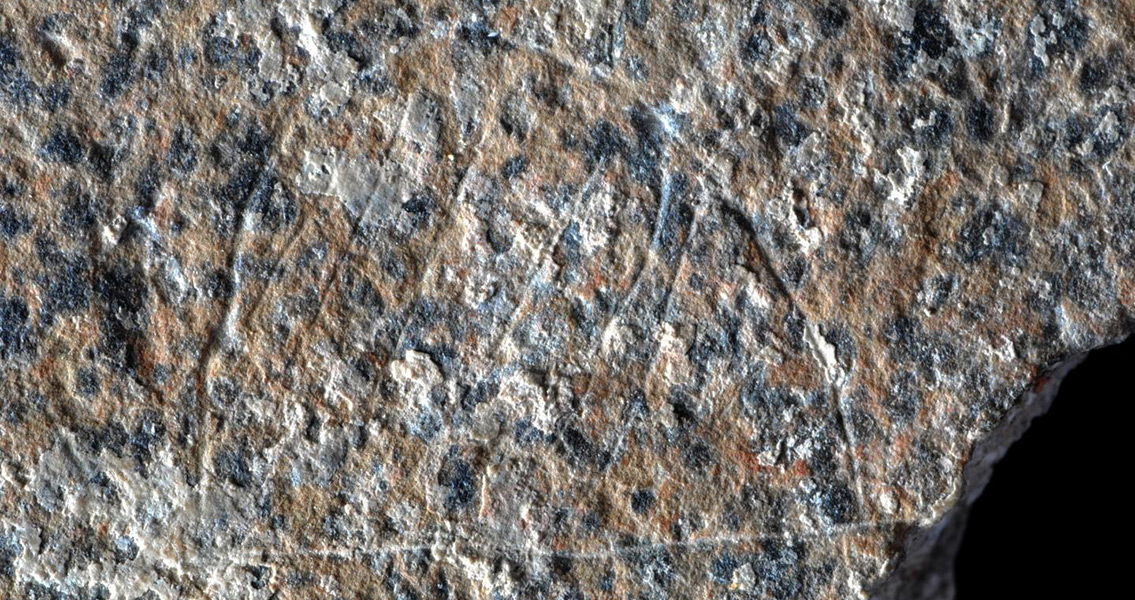<![CDATA[A 13,000 year old engraving discovered in a rockshelter in Spain could depict a hunter-gatherer campsite, making it the oldest known depiction of a human social group ever found. The engraving on a schist slab excavated from the Magdalenian layer of the Moli del Salt site in Northeastern Spain is described in a study by Marcos García-Diez from University of the Basque Country, Spain, and Manuel Vaquero from Catalan Institute of Human Paleoecology and Social Evolution - IPHES, Spain. Their paper is published in the online journal PLOS ONE. Paleolithic art largely focuses on animal iconography, and to a lesser extent, human. Revealing the importance of the animal world to early hunter-gatherer communities, the deeper meanings behind the images are a source of debate among anthropologists. Some interpret them as allegorical symbols, tied in with the formation of early religious beliefs. Others claim the images were rooted firmly in the real world, social motifs linked to everyday life. Whatever the interpretation of the animal figures, it seems that early hunter-gatherers were not interested in depicting the natural landscape, let alone the human landscape (huts, campsites etc). Although artefacts have been found which are claimed to contain depictions of huts, the images are formally undefined and open to alternative interpretations. Garcia-Diez and Vaquero argue that the series of dome like motifs on the schist slab can be seen as depictions of huts. "We suggest that this engraving may be regarded as a naturalistic depiction of a hunter-gatherer campsite." They write in the study. The slab is currently housed in the Institut de Paleoecologia Humana i Evolució Social (IPHES), in Tarragona, Spain. It was excavated in 2013 from a stratigraphic layer at the Moli de Salt site believed to contain artefacts from the Late Upper Paleolithic. A bone fragment excavated 82 cm from the slab was dated to 14,062–13,498 cal BP at 95.4% probability. Measuring 18cm wide, 8.5 cm high and 3.6 cm thick, the prehistoric artwork contains seven engraved semicircular motifs with internal lines arranged in two rows. The lowest level shows a progressive reduction in the size of the motifs from left to right. On the middle and lowest levels the images tend to be aligned or turned to the right, while the top layer shows a single motif on a downward surface and turned to the left. This is taken as evidence that the images are associated with each other. Based on microscopic analysis, the authors conclude that the seven motifs were likely composed using the same instrument and technique over a very short time. "The thematic monotony, the trends in the pattern of engraving (mainly the execution order between the lines and the composition of lines), the diversity in the direction of the engraving conditioned by the possibility of changing the position of the support, the technical homogeneity, and the organization and distribution of the graphic units allow us to argue that the motifs form a compositional unity engraved in a short timeframe." Comparisons with ethnographic data of other hunter-gatherer communities have led the authors to suggest that the slab is meant to depict a Late Upper Paleolithic campsite. Garcia-Diez and Vaquero's study is of course only one possible interpretation of the motifs, but it opens the possibility of "interpreting some of the signs of Paleolithic art as representations of tangible images from real perceptions." The authors argue that the slab is unique because it focuses on a human landscape, pointing to the artist's concern with the human world and perhaps changing our perception of hunter-gatherer culture. "Given the social meaning of campsites in a hunter-gatherer organization, it can be considered one of the first artistic representations of the domestic and social space of a human group." For more information: www.plosone.org Image courtesy of García-Diez et al.]]>
Oldest Image of Hunter-Gatherer Campsite Discovered?
